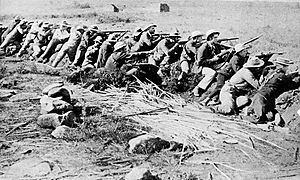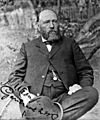Second Boer War facts for kids
The Second Boer War was a big conflict that happened in South Africa a long time ago. It lasted from October 11, 1899, to May 31, 1902. In this war, the powerful British Empire fought against Dutch settlers who spoke Afrikaans. These settlers lived in two independent republics: the South African Republic (also called Transvaal) and the Orange Free State.
The British troops eventually won the war. Because of this, the two republics became part of the British Empire. Later, in 1910, they joined to form the Union of South Africa. This war is often called the Boer War. It's also known as the South African War or the Anglo-Boer War. A famous person named Winston Churchill, who later became a leader, was captured during this war but managed to escape! The British also set up camps where many Boer families were held. This made it harder for the Boer fighters to continue the war.
This conflict is part of a bigger story called the Boer Wars. There was also a First Boer War that happened earlier, from 1880 to 1881.
Images for kids
-
The size of the British Empire in 1898, before the war started
-
A drawing showing Jameson's arrest after his failed raid in 1896
-
Paul Kruger, a leader of the South African Republic (Transvaal)
-
General Redvers Henry Buller led attacks against the Boers early in the war. After several losses, he was replaced by Earl Roberts.
-
The Relief of Ladysmith. Sir George Stuart White greets Major Hubert Gough on February 28. Painting by John Henry Frederick Bacon (1868–1914).
-
General Piet Cronjé as a prisoner of war in Saint Helena, 1900–02. He was captured with 4,000 soldiers after losing the Battle of Paardeberg.
-
A camp for prisoners of war near Cape Town during the war. Prisoners were then sent to other parts of the British Empire.
-
A blockhouse still standing in South Africa. The British built blockhouses to protect their supply routes from Boer attacks.
-
Christiaan de Wet was a very strong leader of the Boer guerrilla fighters. He avoided capture many times and later helped with peace talks.
-
The war ended with the annexation of the Boer Republics by the British Empire in 1902.
-
The peace conference at Vereeniging
-
Tents in the Bloemfontein camp
-
British and Australian officers in South Africa, around 1900
-
The unveiling of the South African War Memorial in Toronto, Ontario, Canada, in 1908
-
Harold Lothrop Borden – the son of Canada's Minister of Defence and the most famous Canadian who died in the war
-
The Natal Indian Ambulance Corps with future leader Mohandas K. Gandhi (middle row, 5th from left)
-
New Zealand troops marching down Wellesley Street, Auckland, to go to South Africa
-
Memorial at Plymouth, by Emil Fuchs
-
A group of British prisoners, with Winston Churchill on the right
See also
 In Spanish: Segunda guerra bóer para niños
In Spanish: Segunda guerra bóer para niños



































